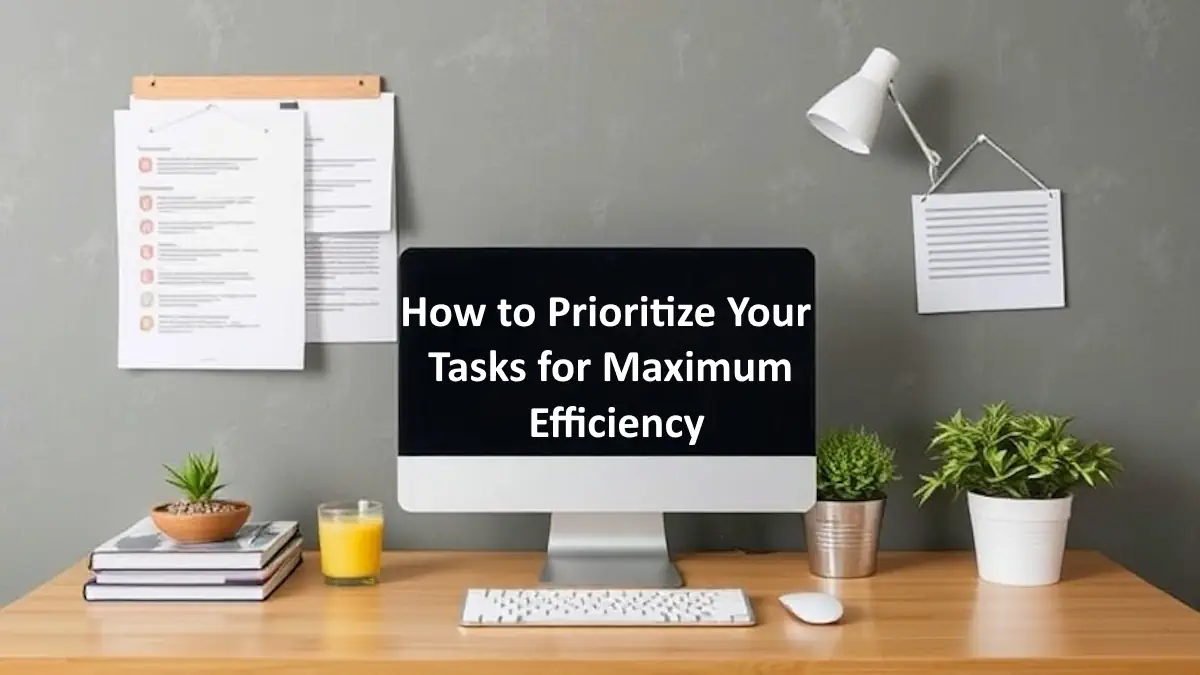Table of contents
Achieving productivity and effective time management starts with prioritizing your tasks. Knowing which tasks need immediate attention and which can wait ensures that you’re working smarter, not harder. Today’s fast-paced environment requires methods that simplify and enhance daily workflows, making prioritization essential for self-improvement. By embracing key prioritization strategies, you can make the most of your time and energy, leading to more significant accomplishments and personal growth.
The Importance of Task Prioritization
When it comes to productivity, many people assume that the more tasks they complete, the better. However, productivity is more about the quality of work than the quantity. Proper task prioritization helps in focusing on tasks that offer the highest impact. Not only does this approach help achieve goals faster, but it also minimizes stress, promotes better work-life balance, and supports self-improvement.
By prioritizing tasks, you give yourself the freedom to excel in areas that truly matter. This practice shifts attention to long-term outcomes instead of short-term urgencies, creating a healthier, more sustainable approach to time management. In essence, prioritization helps you gain clarity, making self-improvement achievable and impactful.
Steps to Effective Task Prioritization for Self Improvement
If you’re ready to maximize productivity and embrace self-improvement, following these steps can lead you toward better task management:
Set Clear Goals and Objectives
Effective prioritization begins with clarity. Setting goals provides a roadmap for where you want to go, both in personal and professional spheres. Start by breaking down broad goals into specific, manageable objectives. For example, if your goal is to increase self-improvement through continuous learning, break that down into daily or weekly activities, such as reading a chapter of a book or attending a relevant workshop.
These smaller objectives will direct your focus, making prioritization straightforward. When each task aligns with a larger goal, prioritization becomes a natural part of your workflow, keeping distractions at bay.
Differentiate Between Urgent and Important Tasks
Understanding the difference between urgent and important tasks is crucial for prioritization. Urgent tasks demand immediate attention and are often tied to someone else’s expectations. Important tasks, however, are those that contribute directly to your long-term goals and self-improvement.
Using the Eisenhower Matrix is an effective strategy for categorizing tasks into four quadrants: urgent-important, non-urgent-important, urgent-not important, and non-urgent-not important. This categorization process enables you to assign importance to tasks wisely, focusing on actions that align with your goals for self-improvement rather than merely reacting to external pressures.
Evaluate and Adjust Daily
Each day comes with new challenges and priorities. What seemed important yesterday might not hold the same significance today. Make it a habit to review your list at the beginning and end of each day, adjusting as needed to align with current objectives. This daily review strengthens adaptability and supports continual self-improvement by keeping your focus sharp.
Delegate When Possible
Delegation is one of the most effective ways to free up time for high-priority tasks. Many people feel reluctant to delegate, fearing a loss of control or a drop in quality. However, by assigning tasks that others can manage, you’ll have more time to focus on tasks that support your self-improvement.
Identify tasks that don’t require your unique skills and delegate them to trusted colleagues or team members. Not only does delegation improve productivity, but it also contributes to a more balanced workload and creates opportunities for others to learn and grow.
Avoid Multitasking
Multitasking may feel productive, but it often reduces the quality of work and increases stress. Instead, focus on one task at a time, dedicating full attention to it. Concentrating on one task ensures better outcomes, helping you stay organized, reduce errors, and improve efficiency. Completing each task individually allows for a more structured approach to self-improvement, enhancing both skill development and productivity.
Time Management Techniques to Boost Efficiency and Self-Improvement
Prioritizing tasks effectively goes hand-in-hand with excellent time management. Employing strategies that support time optimization can help you achieve your goals without feeling overwhelmed.
Utilize Time Blocking
Time blocking is a powerful time-management technique where you divide your day into blocks dedicated to specific activities. Set aside uninterrupted blocks for high-priority tasks, leaving room for breaks and less demanding work. This approach gives structure to your day, reducing time spent on indecision and allowing you to concentrate on self-improvement activities.
Embrace the Pomodoro Technique
The Pomodoro Technique is another time management method that enhances focus and productivity. By working in intervals of 25 minutes, followed by a short break, you maintain energy and minimize burnout. This technique can be particularly useful for tasks that require deep concentration. With regular breaks, you return to your work refreshed, which can significantly benefit your focus on self-improvement tasks.
Plan Your Week on Sundays
Spending a small amount of time each Sunday planning for the week ahead can make a massive difference in productivity. Outline your priorities, schedule tasks according to importance, and set realistic deadlines. This weekly ritual keeps you organized and mentally prepared for the tasks to come, which, in turn, reduces stress and promotes continuous self-improvement.
Limit Distractions
Distractions are productivity killers. If you aim to maximize efficiency, create a distraction-free workspace. Set boundaries, let others know when you’re unavailable, and turn off notifications if needed. This focused environment not only supports productivity but also enhances self-improvement by helping you build better concentration skills.
Strategies to Maintain a Productive Mindset for Self Improvement
Productivity doesn’t solely rely on techniques and schedules; it requires a mindset geared toward growth and continuous improvement. Here are ways to cultivate a productive mindset that can support your self-improvement journey.
Stay Motivated with Personal Rewards
Rewarding yourself for accomplishments keeps motivation high. Set small rewards for completing challenging tasks. This could be as simple as taking a coffee break or treating yourself to something special after a productive week. These rewards reinforce positive habits, making it easier to continue working toward self-improvement goals.
Embrace Continuous Learning
One of the most valuable ways to improve efficiency is by expanding your skill set. Stay updated with the latest tools, software, or knowledge related to your field. By learning continuously, you add to your abilities, making task completion easier and faster. Incorporating learning into your routine is a powerful self-improvement technique that brings long-term benefits to your productivity.
Practice Gratitude
In the quest for productivity, it’s essential to practice gratitude. Acknowledging your achievements, both big and small, keeps you motivated and boosts your mental well-being. This simple habit also promotes self-improvement by allowing you to reflect on progress, appreciate your journey, and continue pushing toward bigger goals.
Tools and Resources to Support Task Prioritization and Self Improvement
Technology offers a range of tools to make task prioritization easier. Here are some popular options:
- Trello: A project management tool that visually organizes tasks into boards and lists, making it easy to see what needs prioritizing.
- Google Calendar: An effective tool for scheduling tasks and setting reminders, keeping you on track for daily and weekly goals.
- Notion: This app offers flexibility in note-taking, project planning, and database management, making it perfect for self-improvement projects.
- Todoist: A task management app that allows you to set priorities, categorize tasks, and monitor progress over time.
How to Use Technology Wisely for Self-Improvement
While tools are useful, using them effectively is essential for achieving self-improvement goals. Avoid the temptation to overuse multiple tools simultaneously, which can lead to confusion and overwhelm. Instead, choose one or two tools that meet your needs best and use them consistently.
Prioritizing tasks effectively and managing your time well are crucial skills for achieving maximum efficiency. By setting clear goals, avoiding multitasking, and adopting the right tools, you can streamline your tasks and make meaningful strides toward self-improvement.













1 thought on “How to Prioritize Your Tasks for Maximum Efficiency”